A
AengusOg
Guest
Thanks for the info, chev.You know, some clever souls on this side of the Atlantic are breeding colored cobs with lots of feathering and calling them "Gypsy Vanners" (as the above poster noted). You'd fall out of your saddle to see the prices they're getting for them!
It's just another one of those made-up "breeds," of course, like the labradoodles (doG help us) that people pay a lot of money for, when there are plenty of nice mixed-breeds at the animal shelter needing homes.
Now I see the people who made up the "breed" also apparently muddled up the name.
Actually, the way it happened was that the army were buying remounts (for the first world war), but didn't want coloured horses as they would have been too obvious in the landscape in battle conditions..............
Few decent self coloured horses were left for farmers and hauliers, so coloured horses became about the only thing available to non army buyers for a while, and they were cheap to buy...........that's how the gypsies and travellers got into them initially.........buying coloured horses, working with them a bit, then selling them to those who needed them.
The gypsies are very fond of things of beauty, particularly if they have a large monetary value, and so the horses became an emblem of wealth and horsemanship/breeding for those families who became deeply involved.
I think you're a bit off the mark when you say they are just a 'made up' breed.
The (coloured) horses which went first to America were sourced from some of the oldest established gypsy/traveller families in Britain, who have been breeding these horses for generations, and know pedigrees off by heart.
These horses have been bred for ability to perform the tasks they were intended for, ie pulling living waggons/light drays, road racing, etc..
However, as I understand it, the vanner cob was a horse standing no taller than 15 hh; a taller horse would not have the same ability to efficiently pull a load, as a horse with a low centre of gravity has greater power for such work.
Many of the waggon horses are between 13.2 and 14.2 hh, and they manage the job very well.
Fifty years ago, when milk/coal/vegetables and the like were sold around the towns and villages, the horses which drew the drays were vanners in the true sense of the word..........they pulled the milk van, the fruit and veg van, the rag and bone van, and so on.
The city of Edinburgh still had vanners working into the early 1960's, St. Cuthbert's Dairy and the Cooperative being some of the last to change over to motorised vehicles.
I've got coloured horses here............I just call them coloured cobs.
Gypsy cobs are coloured horses with a bit of bone and feather, and can range in size and build, whereas vanners are more a type of cob, more suited to the job owing to their size and build.
Some of the American buyers came over to England to visit the horse fairs with the gypsy breeders who were their 'advisors' on their route into coloured cobs. Studs were visited and the buyers went away with some of the best examples of the types that their big money could buy.
Horses such as 'Galway Warrior' and 'Drummer' (one of the English queen's parade horses) went to America to start stud work there and, being America, the prices for stud fees and young stock rocketed to heights previously only dreamt of.
I don't see why you'd refer to these types as 'made up breeds' when you have such oddities as Tennessee Walking Horses and American Saddle Horses (the conformational differences between which are a mystery to me), not to mention the American Shetland Pony..........all nice in their own right, but no less bred for purpose than some lines of gypsy cobs.
I think it will be interesting to see what the American breeders do with the gypsy horses they paid so much for............i hope I'm around, in forty or fifty years, to witness the fruits of their labours.........I hope not to be disappointed.
What's your take on it, Peace?
Last edited by a moderator:





